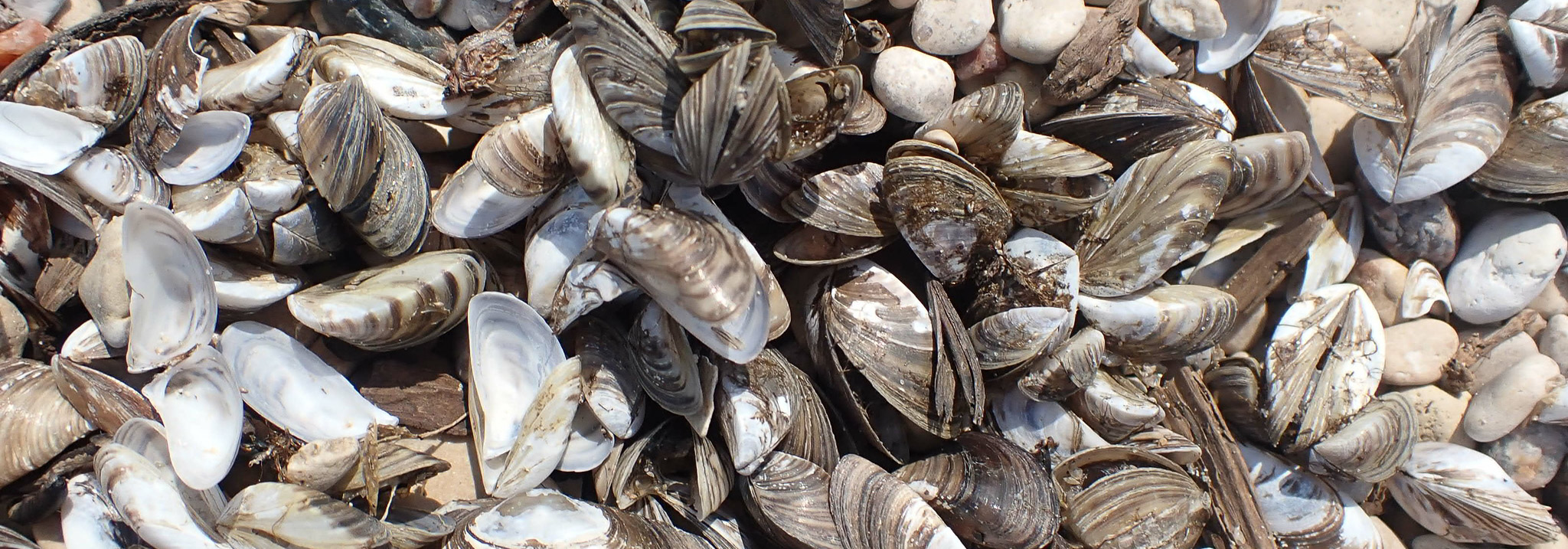Moncton, NB – Since last summer’s detection of Zebra Mussels in Lake Temiscouata, Quebec, Fisheries and Oceans Canada (DFO) and its provincial, municipal, non-governmental and Indigenous partners have been closely monitoring New Brunswick’s lakes and rivers for any new presence of the aquatic invasive species (AIS).
Some water samples taken from the Saint John River, N.B., were analyzed for environmental DNA (eDNA) by DFO over the summer. These samples suggested the presence of Zebra Mussels, notably in the areas of Edmundston, Grand Falls and Nackawic, N.B.
Recently, collective monitoring efforts in these areas led to the sighting of live Zebra Mussels along a hydroelectric dam in Edmundston. The dam is located on New Brunswick’s Madawaska River, about 40 kilometres downstream from Lake Temiscouata. DFO confirmed that the specimens collected at the dam by the Société d’aménagement de la rivière Madawaska (SARM) in late August, 2023, are Zebra Mussels. This marks the first confirmed observation of this aquatic invasive species in N.B. waters.
Once established, Zebra Mussels can have negative impacts on freshwater habitats. They are particularly harmful to native mussels, many of which are species at risk. Zebra Mussels monopolize their food, such as plankton, and attach themselves to native mussels, suffocating them. Every year, Zebra Mussels cause millions of dollars in damage in Canada by clogging intake structures in power stations and water treatment plants, and by damaging boats.
Thanks to the Aquatic Invasive Species Prevention Fund, a new contribution fund launched earlier this year, DFO is supporting the Organisme de bassin versant du fleuve Saint-Jean (OBVFSJ) and its partners in the implementation of an Action Plan to limit the spread of Zebra Mussels throughout the Saint John River watershed.
The Action Plan, which is a collaborative effort between stakeholders in Quebec and New Brunswick, will map areas that are most vulnerable to the presence of Zebra Mussels and ensure that a network of boat washing stations is set up in key locations. These stations will teach boaters how to stop the spread of Zebra Mussels by cleaning, draining and drying their watercraft. In addition, a public education and awareness campaign on best practices to control the spread of this aquatic invasive species will be launched.
The introduction and spread of aquatic invasive species is a significant and rapidly growing threat globally, nationally and locally. In New Brunswick, close collaboration between the federal government and the provincial government is key to ensuring the effective control and management of aquatic invasive species and to conserve and protect fish and fish habitat across the province.
“The Zebra Mussel damages and wreaks havoc on Canada’s freshwater ecosystems, and to stop its spread, the Government of Canada is supporting the Organisme de bassin versant du fleuve Saint-Jean through the Aquatic Invasive Species Prevention Fund. We’re building a strong regional network that provides scientific and technical support to combat these invasions.” – The Honourable Diane Lebouthillier, Minister of Fisheries, Oceans and the Canadian Coast Guard
Quick Facts
- Aquatic invasive species (AIS) are non-native species of fish, invertebrates or plants that have been introduced into a new aquatic environment, outside their natural range. They pose a serious threat to the biodiversity of Canada’s waters, economy and society.
- Environmental DNA (eDNA) sampling is used to guide monitoring efforts for Zebra Mussels and other aquatic invasive species. The technique allows us to detect the presence of genetic material of a targeted species in an ecosystem without having to directly observe it. A visual observation must be made to confirm that live specimens are present in a body of water.
- At any stage of their life cycle, Zebra Mussels can be transported, unnoticed, from one body of water to another via residual water or by attaching themselves to ships, boats and other watercrafts, as well as to nautical and fishing equipment, like floating docks. Its larvae are microscopic, float in the water and follow the currents of lakes and rivers until they attach to a solid surface. They are a fresh-water species.
- The Aquatic Invasive Species Prevention Fund will provide $8.75 million in contribution funding from fiscal years 2022-23 to 2026-27. It will strengthen partnerships between the federal government, provinces and territories, Indigenous communities, stakeholders and the general public. These partnerships will facilitate on-the-ground, preventative actions against aquatic invasive species as well as education, outreach, detection and response activities.
- Fisheries and Oceans Canada (DFO) is working with the following non-governmental partners to prevent the spread of Zebra Mussels in New Brunswick: Organisme de bassin versant du fleuve Saint-Jean (OBVFSJ), New Brunswick Invasive Species Council (NBISC), Northwest Regional Service Commission (NRSC), Société d’aménagement de la rivière Madawaska (SARM), Comité de l’aménagement rural du Nord-Ouest (CARNO) and Nature-Loisirs Lac-Baker.









